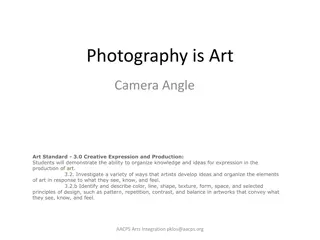Mastering Photographic Composition: Tips and Techniques
Understanding the art of photographic composition is essential for creating visually appealing images. This guide covers key concepts such as simplicity, the rule of thirds, and consideration for moving subjects to help you enhance your photography skills and create compelling pictures.
Download Presentation

Please find below an Image/Link to download the presentation.
The content on the website is provided AS IS for your information and personal use only. It may not be sold, licensed, or shared on other websites without obtaining consent from the author. Download presentation by click this link. If you encounter any issues during the download, it is possible that the publisher has removed the file from their server.
E N D
Presentation Transcript
Photographic Composition is the pleasing selection and arrangement of subjects within the picture area.
We chose the cactus as the main subject. And by moving in closer and using the plain sky as the background, we have simplified and improved the appearance of this photograph.
Rule of Thirds You can use the rule of thirds as a guide in the off-center placement of your subjects. Here's how it works.
Before you snap the picture, imagine your picture area divided into thirds both horizontally and vertically. The intersections of these imaginary lines suggest four options for placing the center of interest for good composition. The option you select depends upon the subject and how you would like that subject to be presented.
You should always consider the path of moving subjects and, generally, leave space in front of them into which they can move. If you don't, here's what can happen! This jogger looks like she's going to run right out of the picture.
By placing the subject in the lower-left position, we've used the rule of thirds and given the jogger plenty of room to run within the picture.
You can also apply the rule of thirds guidelines to the placement of the horizon in your photos. Here the center position of the boat and horizon results in a static feeling.
Just as it's usually best to place horizons off center, it's also best to place verticals off center. For instance, in the picture on the left, the subject is centered, but on the right, the photographer got a more effective photograph by simply changing the viewpoint.
Lines Lines also play an important role in composition. This sculpture has some beautiful lines, but they're obscured by the busy background. Let's simplify this picture by moving our camera viewpoint in close to the base of the sculpture. Now we can look up and see the lines against a clear blue sky. The picture on the right is much more dynamic because of the strong diagonal lines
You can use diagonals as leading lines to provide a way into the picture. It's a simple and easy path for the eye to follow to the main subject.
Repetitive lines are the same line repeated over and over.
You can also use Leading lines to draw viewers' attention to your center of interest.
One of the most common and graceful lines used in composition is called the S curve.
You can use other simple geometric shapes to help your picture composition. Can you see the triangle you get by connecting imaginary lines between the three nuns? This triangle adds strong visual unity to this picture.
Balance Achieving good balance is another one of our guidelines for better picture composition. Notice how the leaves, the window, and the couple all seem to be in the right place. The camera viewpoint and subject placement were all carefully selected to create this well-balanced photograph.
Good balance is simply the arrangement of shapes, colors, or areas of light and dark that complement one another so that the photograph looks well-balanced, not . . . . . . lopsided like this. This child looks like she's going to fall right out of the picture due to lack of visible support.
Imagine that these two couples are standing at either end of a pair of scales. They are evenly balanced, so this is a classic example of symmetrical balance.
Here's an example of asymmetrical balance. The large single head balances the smaller child on the right. In general this type of balance is more interesting to look at than symmetrical balance.
For example, this is a balanced photograph, but the subjects can be separated into two vertical pictures-which tends to divide the viewer's attention.
There are usually several ways to arrange or balance your subjects. You may choose the style on the left because you'd like to convey a feeling of formality-or you may prefer the more relaxed informal pose. They're both well balanced.
Another guideline for improving photographic composition is framing. What we mean is to frame the center of interest with objects in the foreground. This can give a picture the feeling of depth it needs to make it more than just another snapshot.
The Washington Monument on the left is composed in the center without a frame. The picture on the right has a stronger feeling of depth and tells a more complete story because the photographer chose an appropriate foreground to complement the Washington Monument.
The horses and their riders add considerable foreground interest to this scene. The overhanging tree branches complete the frame and add depth to the subject. When you use people for scale and foreground, make sure they look into the picture area.
Avoiding Mergers The background merger of this tree with this man s head is so obvious, you probably think no one could avoid seeing it before snapping the shutter. Remember: we see things in three dimensions, so it's easier than you might guess to focus our eyes on the principal subject only and not see that background at all.
This is a fun picture, but when we cut people in half or trim their heads or feet, we've committed a border merger. This is often caused by poor alignment of the photographer's eye in the camera viewfinder. To avoid border mergers, line your eye up squarely behind the viewfinder and adjust the picture format to leave a little space around everyone.
Near mergers may not be quite as objectionable, but they can steal attention from your center of interest. Near mergers are objects or lines that are just too close to the principal subject. In this case the ball and umbrella tip are near mergers.
Viewpoint Selecting your viewpoint, the position from which you photograph the subject, is a very important part of composition and one that some people pay very little attention to. When taking a photo of a group of friends, how often do you move around the group looking for the best angle?
The Most important thing when taking a photograph is to take the time to think and plan. -Plan out what you want the composition to be and how you are going to adjust it. -Look back at these notes and use them when you are taking your pictures.

















































